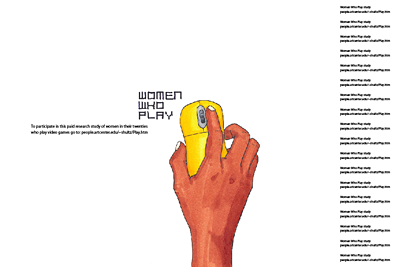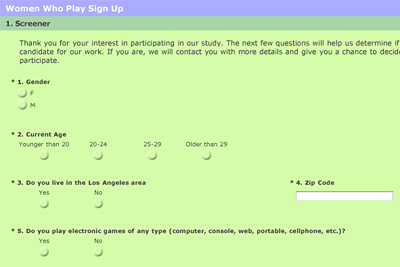Project and
Methods:
Recruiting:
Process:
Using online resources to streamline recruiting
Recruiting for Super Studio projects has been completed in various ways. Each member of the Flip it 180 class was responsible for finding their own baby boomer participant. In the Mobo and Blux years a market research recruiting firm was used to recruit tweens and six-year-old boys, respectively. Passing on the future used craigslist to find families with teens. The use of a market research recruiting company enabled for having participants that met a very strict criteria, and represented very little work for the researchers beyond designing the screener for the firm to use. It is also prohibitively expensive for a student project.
While evaluating craigslist for recruiting for Women Who Play, it became evident that UCLA, along with other local universities, and market researchers were already using it for recruiting purposes. There was a definite place and a vernacular for such ads. The main complaint among students using craigslist was the sure amount of work managing the responses took. With this in mind, a four step process for recruitment was developed.



Women Who Play recruitment website, flier, and online screaner.
The third step in the process was a link from the website to an online screener. Using the online tool Surveymonkey, it was possible to create a screener that potential participants could self fill out. (Surveymonkey.com is usually used as a site for conducting complete surveys, not as a screening tool.) The screener gathered biographic information and at what level the women wished to participate (activity pack only, activity pack and home interview, activity pack and on-campus interview.) The output from Surveymonkey was a spreadsheet with all of the responses. From this the final selection of participants was made. The final step was contacting the women and inviting them to participate (most had selected to be contacted by email.) It was then possible to answer the few remaining questions the women might of had.
This unique process made it possible for one researcher to get a large pool of candidates and choose from them with very little effort. Compared to previous techniques it reached its target number of participants faster, was less expensive--the only cost was $20 to Surveymonkey--and required much less time from the researcher. Other students in the MDP have since used a similar process and gotten similar results.
There are two main downsides to this recruitment technique. First, the researcher and participant may never talk before the day of the interview. One subject in this study choose to participate in an interview but would only answer in short three word sentences. With other techniques it would have been easy to screen out such a person. Secondly, this technique--especially the use of craigslist--leads to all the participants being self-selecting. They think of themselves as someone who plays games; they are the sort of person who reads craigslist looking for paid surveys; they have a certain proficiency and comfort with the internet. While none of those things invalidates this research, they do add a nuance to the work that shouldn't be overlooked.
In terms of this study there was a diversity in economic levels, however it was weighted toward the lower end. It is hard to quantify because people in their twenties are all in transition and can quickly go through phase of high and low disposable incomes and participants were not asked how much they made. (In the Blux study we found that people often lied about this in order to be included.) The participants were paid in cash. It is an open question if a gift card to a store that sold non-necesity items (say to a video game store) might attract a wider demographic then a cash payment.